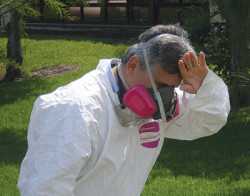Stay Safe And Beat The Heat

August marks the dog days of summer for Florida growers and fieldworkers, so take care to protect against overheating. People overheat when their bodies are unable to get rid of excess heat fast enough. If not managed, heat exhaustion, heat stroke, and even coma and death are possible. Pesticide applicators are especially vulnerable because they are buried under layers of personal protective equipment. Some applicators may succumb to temptation and not wear equipment in order to stay cooler. This is illegal and unnecessarily exposes them to pesticides.
It is important to understand the difference between heat stress, heat exhaustion, and heat stroke.
Heat stress is a buildup of excess heat within the body. Symptoms may include some mild dizziness, impaired judgment, poor concentration, and fatigue.
Heat exhaustion occurs when heat or humidity result in increasingly greater fatigue, weakness, coordination loss, and even fainting. Excessive sweating may be experienced, along with increased pulse rates, heat cramps, nausea, rapid breathing, slurred speech, and irritability.
Heat stroke is the most severe and undesirable malady and may show up suddenly. It can include headache, dizziness, confusion, convulsions, and coma. Sweating may decrease or stop, speech may become incoherent, and the victim can become violent. An internal body temperature rise of 5°F or more often leads to heat stroke, with a large percentage of victims dying.
Drink Plenty Of Water
This is not as much of a “no-brainer” as it may sound. Replacing water lost through sweating is the most important technique to avoid heat exhaustion and heat stroke. Workers can lose up to two quarts of perspiration per hour or three gallons per day on very hot days. This may not necessarily show up as heavy sweating if humidity levels are low and evaporation is occurring. The EPA recommends drinking liquids on a schedule, even if the worker is not thirsty. On hot days, it recommends drinking a pint of water before starting work and a cup or more per half-hour as conditions dictate.
Dramatic body weight loss of a few pounds during the day is another indicator that not enough fluids are being consumed. Alcoholic and excessive caffeine drinks add to the problem. People generally drink more water if the liquid’s temperature is cool, but not cold or hot.
Acclimatize Workers To Heat
It takes a week or longer for people working a minimum of almost two hours per day to become acclimated to hot and humid weather. Being in good physical condition helps, but is quite different from heat conditioning. The safest and most effective way to acclimatize is to slowly increase the time worked in the heat. Individuals may appear to be acclimated after just a couple of days, but are more likely to experience heat problems if they do not go through an entire seven days of getting accustomed to conditions. Acclimatization can be lost beginning after about four days of not working in the heat and humidity.
Take Breaks To Cool Down
Cooling down means taking breaks in the shade. Cooled rooms or vehicles are even better. Breaks allow time for excessive body heat to dissipate, for the heart rate to decrease, and time to drink fluids. Acclimated workers in protective applicator gear should take a 10-minute break every hour. A five-minute break every half hour is even better, if possible. This should be increased significantly for applicators in pesticide-resistant suits and when temperatures and relative humidity are high.
When frequent removal of protective equipment is impractical or dangerous, cooling vests worn under the protective suit are helpful. Another way to avoid frequent breaks is to time pesticide applications during the cooler parts of the day. This is also a good recommendation to help avoid pesticide toxicity to crops. Adjusting workloads during hot and humid periods may result in greater productivity over the long term.
Be Aware Of Temperature And Humidity
Keep track of current temperature and humidity conditions. Temperatures approaching 80°F or more can cause problems even under moderate physical working conditions. High humidity levels significantly add to heat stress, especially if there is little or no wind. Heavy physical work is dangerous during periods of high temperatures or high humidity. Shaded work areas with fans for certain activities can reduce the need for cool-down periods.
How To Help The Overheated
When heat problems are encountered, loosen clothing, move to a cool, shaded area, and drink plenty of water if conscious. Cool, moist towels or splashed water on the skin also helps. Avoid taking in salt, which leads to more dehydration. It may take up to 30 minutes for a person’s internal body temperature to drop back down to appropriate levels. If more severe symptoms are observed, cool the person as quickly as possible and treat for shock, if it occurs. Seek medical help immediately.
Lack of adequate sleep, heavy alcohol consumption the day before, drug use, illness, sunburn, recent immunizations, antihistamines, cold medications, and some tranquilizers can all increase the chances for heat problems. Use care and you can avoid these problems during the sizzling summers.









